Parabola - Conic Section (Lecture-01)
A conic section or conic is the locus of a point
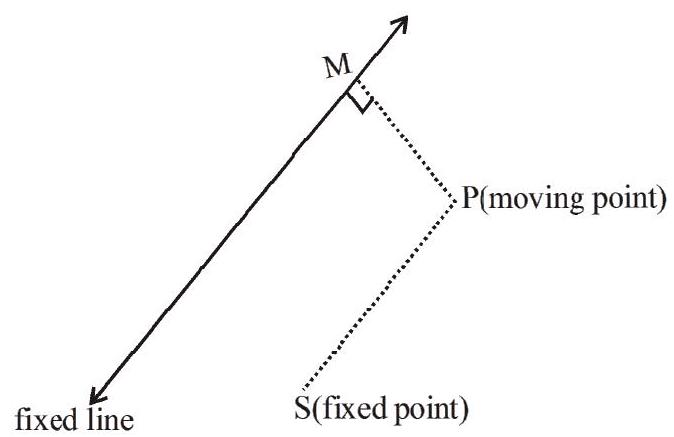
- The fixed point known as Focus.
- The fixed straight line is known as Directrix,
- The constant ratio is called the Eccentricity denoted by e.
- The line passing through the focus and perpendicular to the directrix is known as axis.
- A point of intersection of a conic with its axis is called a vertex.
- The point which bisects every chord of the conic passing through it, is called the centre of the conic.
- The chord passing through the focus and perpendicular to the axis is known as Latus Rectum.
GENERAL EQUATION OF A CONIC SECTION:
Let coordinates of focus be
Thus locus of
This is equation of conic section which, when simplified, can be written in the form
Section of right circular cone by different planes
A right circular cone is as shown in the figure -1
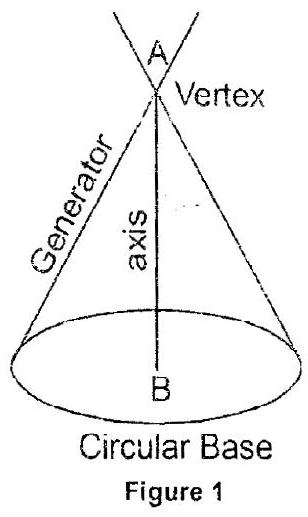
i. Section of a right cone by a plane passing through its vertex is a pair of straight lines passing through the vertex as shown in the figure -2 .
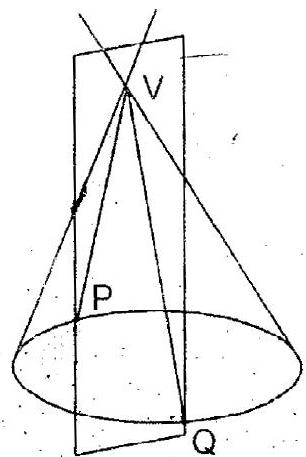
Figure -2
ii. Section of a right circular cone by a plane parallel to its base is a circle as shown in the figure -3 .
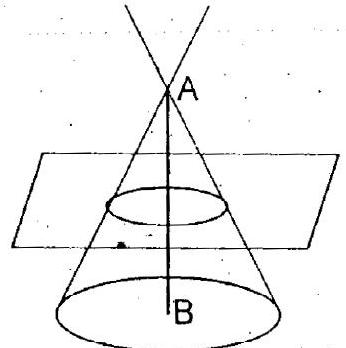
Figure- 3
iii. Section of a right circular cone by a plane parallel to a generator of the cone is parabola as shown in the figure -4 .
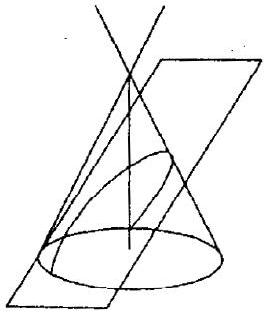
Figure-4
iv. Section of a right circular cone by a plane neither parallel to any generator of the cone nor perpendicular or parallel to the axis of the cone is an ellipse as shown in the figure -5 .

v. Section of a right circular cone by a plane parallel to the axis of the cone is a hyperbola as shown in the figure -6 .
3D View :
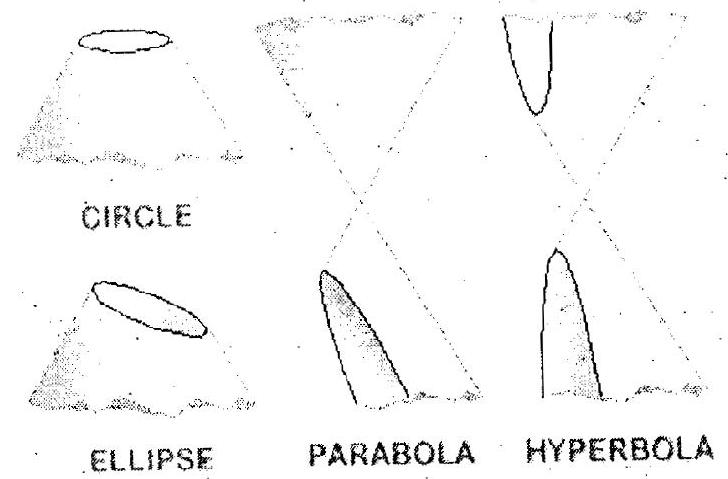
Distinguishing various conics:
The nature of the conic section depends upon the position of the focus with respect to the directrix and also upon the value of the eccentricity.
1. If focus lies on the Directrix.
General equation of a conic represents a pair of straight lines, if
2. If focus does not lie on Directrix.
i.
ii.
iii.
iv.
v.
Vertex
Tangent of lotus rectum
Extremities of lotus rectum (a, 2a), (a,
Length of lotus rectum. 4a
Focal distance (SP)
Parametric form
Focal distance - the distance of a point on the parabola from the focus
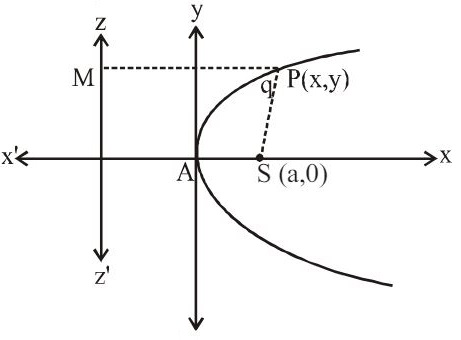
Focal chord - A chord of the parabola, which passes through the focus.
Double ordinate - A chord of the parabola perpendicular to the axis of the parabola.
Latus Rectum-A double ordinate passing through the focus or a focal chord perpendicular to the axis of parabola.
- Perpendicular distance form focus on directrix = half the latus rectum.
- Vertex is middle point of the focus and the point of intersection of directrix and axis.
- Two parabolas are said to be equal if they have the same lotus rectum.
Other Standard Forms of Parabola:

| Equation of curve: | |||
| Vertex | |||
| Focus | |||
| Directrix | |||
| Equation of axis | |||
| Tangent of vertex | |||
| Parametric form |
Position of a point with respet ot Parabola

Equation of Parabola when vertex is shifted.
I. Axis is Parallel to
Let vertex
II. Axis is parallel to y-axis:
Let vertex
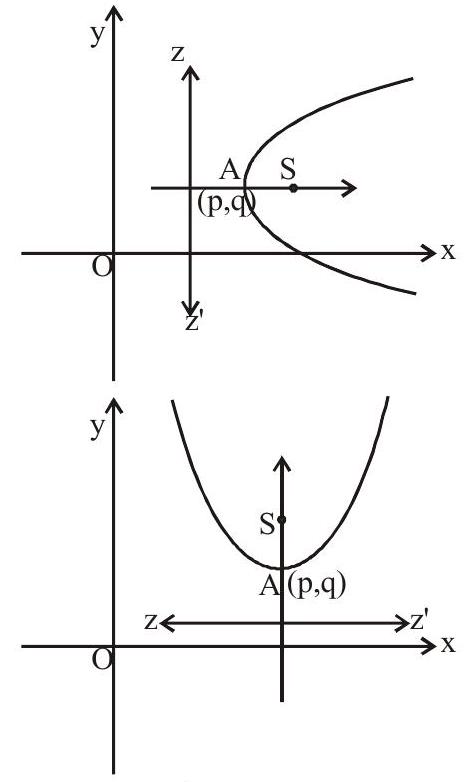
Parametric Form:
| Parametric coordinates |
Properties of Focal chord:
1. If the chord joining
2. Length of focal chord is
3. The length of the focal chord which makes an angle
4. Semi latus rectum of a parabola is the harmonic mean between the segments of any focal chord of the parabola.
5. Circle described on the focal length as diameter touches the tangent at vertex.
Equation of tangent:
| Parabola | Point form | Pt. of contact | Parametric form | Pt. of contact | slope form | Pt. of contact |
|---|---|---|---|---|---|---|
Pair of Tangents from point
Let eq
Equation of pair of tangents is
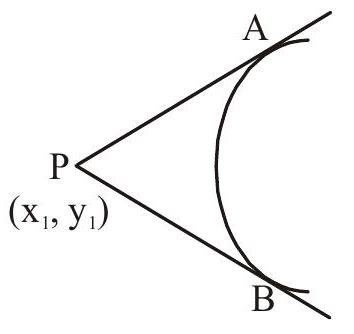
Properties of Tangents:
1. Point of intersection of two tangents of the parabola:-
Equation of tangent at
Equation of tangent at
Solving these equations, we get
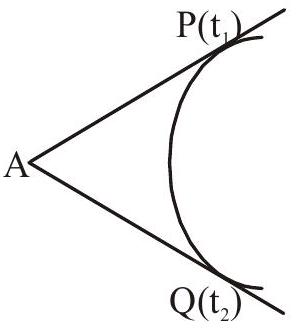
2. Locus of foot of prependicular from focus upon any tangent is tangent at vertex:-
Equation of tengent at
Let the tangent meet
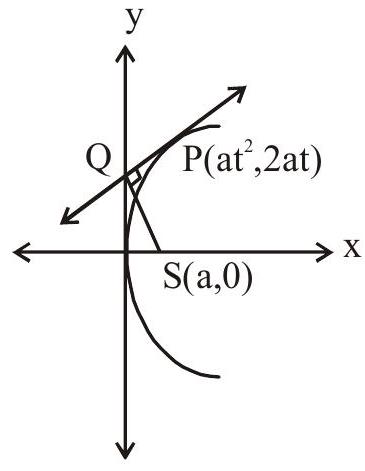
3. Length of tangent between the pt. of contact and the point where tangent meets the directrix subtends right angle at focus:-
Equation of tangent at
Point of intersection with directrix
slope
slope
4. Tangent at extremities of focal chord are perpendicular adn intersect on directrix
(Locus of intersection point of tangents at extremities of focal chord is directrix)
Let
Equation of tangent at
Equation of tangent at
Point of intersection of both tangents, we get after sloving (1) & (2) i.e.
A point lies on the directrix.
Example: 1 The focal chord to
(a)
(b)
(c)
(d)
Show Answer
Solution: The focus of parabola is
Answer: a
Example: 2 The curve represented by
(a) a circle
(b) a parabola
(c) an ellipse
(d) a hyperbola
Show Answer
Solution:
Answer: b
Example: 3 The equation of the directrix of the parabola
(a)
(b)
(c)
(d)
Show Answer
Solution:
Equation of directrix is
Answer: d
Example: 4 The locus of the midpoint of the segment joining the focus to a moving point on the parabola
(a)
(b)
(c)
(d) none of these
Show Answer
Solution: Let
Mid point of PS is Q.
Locus of
Equaiton of directrix is
Answer: c
Example: 5 The angle between the tangents drawn from the point
(a)
(b)
(c)
(d)
Show Answer
Solution: Equation of tangent of the parabola
This equation passes through
Angle between the two tangents is
Answer: c
Exercise: 6 Tangent to the curve
(a)
(b)
(c)
(d)
Show Answer
Solution: Equation of tangent at
This line also touches the circle i.e.
Equation of normal of circle passing through
centre
Answer: d
Exercise: 7 Consider the two curves
(a)
(b)
(c)
(d)
Show Answer
Solution: Let eq
Exercise: 8 If b,
(a)
(b)
(c)
(d)
Show Answer
Solution: We know that
Answer: d
Exercise: 9 The circle
(a)
(b)
(c)
(d)
Show Answer
Solution: Let
Answer: a
Exercise: 10 A tangent PT is drawn at the point
(a)
(b)
(c)
(d)
Show Answer
Solution:
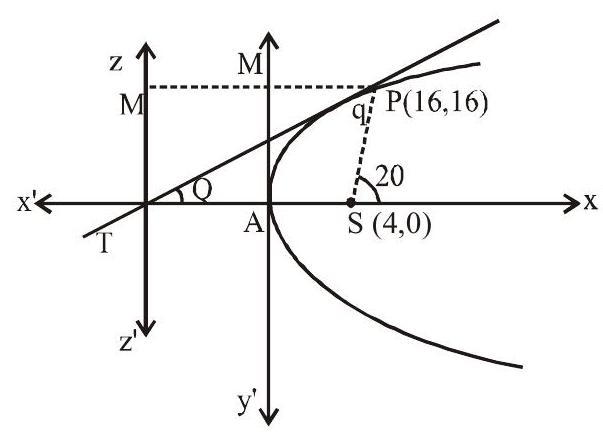
Answer: a
Exercise: 11 If
(a)
(b)
(c)
(d)
Show Answer
Solution: Equation of normals are
Equation 1 and 2 are identical then
For
Answer: d
Exercise: 12 If
(a)
(b)
(c)
(d)
Show Answer
Solution: Let coordinates of
In
In
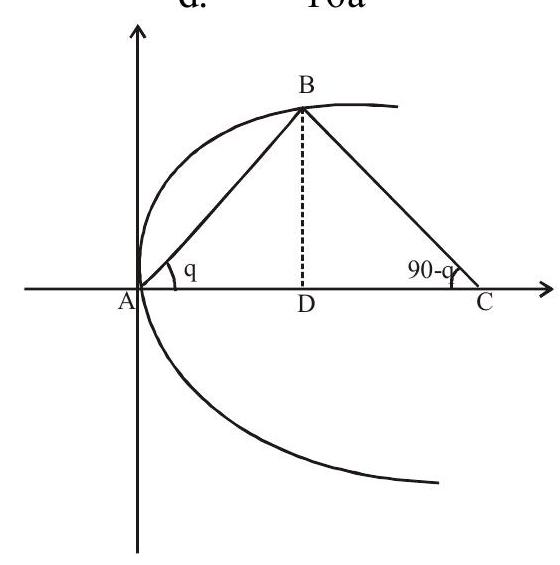
Answer: b
Exercise: 13 A circle is descirbed whose centre is the vertex and whose diameter is three-quarters of the latus rectum of the parabola
(a)
(b)
(c)
(d)
Show Answer
Solution: Centre of circle
diameter
Eq of circle
coordinates of
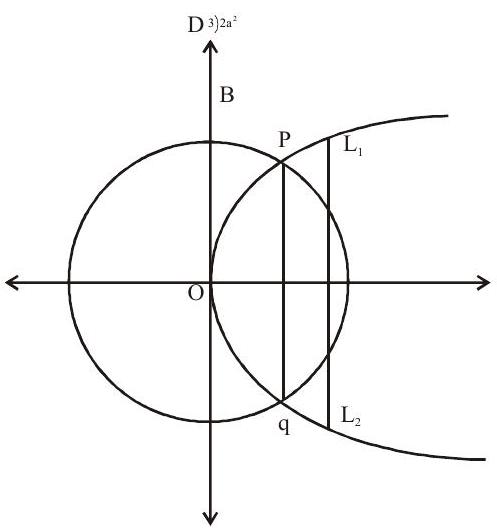
Area of trapezium
Answer: a
Exercise: 14 From the point
(a)
(b)
(c)
(d)
Show Answer
Solution: Let equation of normal be
It passes through
Points are
Centroid is
Answer: d
Exercise: 15 A ray of light travels along a line
(a)
(b)
(c)
(d)
Show Answer
Solution:
Focus
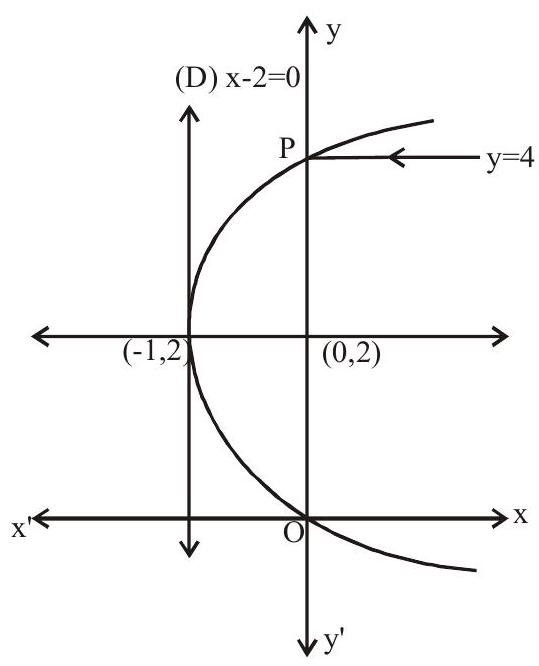
Incident ray is parallel to axis of the parabola, so reflected ray passes through focus
Exercise: 16 Let
(a) 6
(b) 8
(c) 10
(d) 11
Show Answer
Solution: Equation of parabola is
focus
equation of directrix
Coordinates of
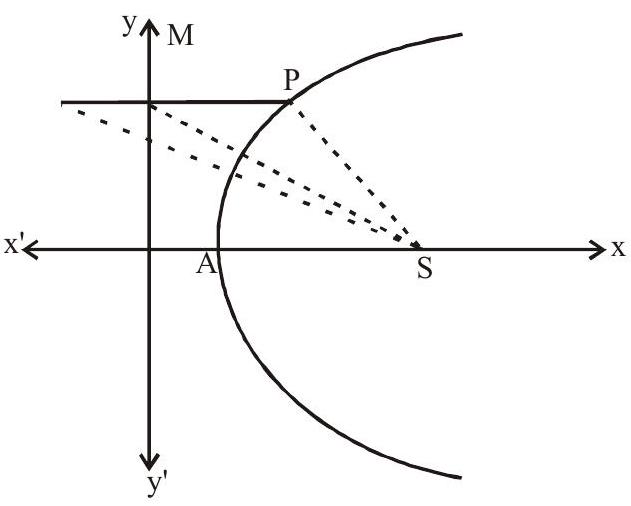
Length of side
Answer: a
Exercise
1. The point
(a)
(b)
(c)
(d)
Show Answer
Answer: b2. Two perpendicular tangents to
(a)
(b)
(c)
(d)
Show Answer
Answer: a3.
(a)
(b)
(c) does not have any common tangent.
(d)
Show Answer
Answer: a4. Two common tangents to the circle
(a)
(b)
(c)
(d)
Show Answer
Answer: c5. The number of points with integral coordinates that lie in the interior of the circle
(a) 6
(b) 8
(c) 10
(d) 12
Show Answer
Answer: b6. The vertex of the parabola
(a)
(b)
(c)
(d)
Show Answer
Answer: d7. The length of the latus rectum of the parabola
(a)
(b)
(c)
(d)
Show Answer
Answer: c8. The point on
(a)
(b)
(c)
(d)
Show Answer
Answer: a9. The angle between the tangents drawn from the origin to the parabola
(a)
(b)
(c)
(d)
Show Answer
Answer: c10. The circle
(a)
(b)
(c)
(d) none of these










